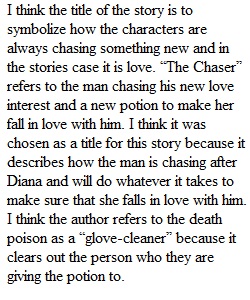


Q Semiotic and Gender Analysis of 4 Stories and Main Characters – 35 points For this assignment, you should consider 4 short stories: “The Lottery,” “The Chaser,” “Button, Button,” and “The Story of an Hour” and answer to 11 questions providing your semiotic and gender theory analysis/responses. I. Semiotic Analysis: (16 points for questions 1-6) For the questions 1-6 provide your brief response of 3-5 sentence each 1) Consider the title “The Chaser” and explain the possible meaning(s). Do not only state the meaning, but also explain why do you think this was chosen as a title for this story? (2p) How will YOU (not the Internet) explain the meaning of these words/ phrase? 2) From the story “The Chaser” consider the word “glove” or the phrase “the glove cleaner” How will you interpret the meaning of it? Why do you think the old man calls the death poison a “glove-cleaner”? (2p) 3) From “The Story of an Hour” consider the phrase “She died of the joy that kills” Can joy kill a person? Do you think Louise died because she was indeed happy to see her husband alive? Or do you think she died because of her heart condition that couldn’t tolerate so much happiness for Brently’s return? Or what do you think? Briefly explain! (2p) 4) Consider the title “Button, Button” and provide your thoughts on this title after reading the story. Why do you think the author chose such a title and why the word “Button” is repeated? (provide YOUR interpretation). (2p) 5) If you were to change this title, what title would you choose for this story? State YOUR preferred title and EXPLAIN why. (2p) 6) Think of the meaning of “death” in the 4 stories: “The Lottery,” “The Chaser,” “The Story of an Hour,” and “Button, Button.” One of the main characters in these 4 stories is doomed to death (either dies or is expected to die). Compare the endings of these 4 stories in relation to the meaning of “death.” Do you think death has a literal meaning of passing away/ losing their life or means “the end” of something in each of these 4 stories? Why do you think so? Explain. In 5-8 sentences provide YOUR interpretation of “death” being the ending of the main characters of these 4 stories. (6p) __________________________________ II. Analysis from the Gender Perspective (19 points for questions 7-11) Power, Privilege & Superiority based on Gender expectations. In the patriarchal society, men are seen more powerful, reasonable, decisive, smart, independent, and have more privilege than women, who should be more passive, submissive, quiet, dependent. A. Gender Superiority/ Inferiority: Consider the main characters of these 4 stories and discuss how these characters perform their gender roles; do they adhere to the patriarchal social ideologies (that is to say, do the male characters have more power and privilege than the female characters? In a brief paragraph of 5-6 sentences state your opinion / your gender analysis for each story. Briefly state how each of this main character’s “perform” their expected gender roles, what is their relationship as a couple/ within a family unit, and based on these, how can you define /describe “Gender Ideology and gender expectations” in the societies of these stories. 7) Gender in “The Lottery” (Mrs. Tessie Hutchinson and Mr. Hutchinson- their relationship) (3p) 8) Gender in “The Chaser” (Allan and Diana) (3p) 9) Gender in “Button, Button” (Mrs. Norma Lewis and Arthur) (3p) 10) Gender in “The Story of an Hour” (Mrs. Louise Mallard and Brently) (3p) __________ B. “The CULT of TRUE WOMANHOOD” and our 3 FEMALE CHARACTERS In the 19th century, Victorian patriarchy promoted the “cult of true womanhood”, which depicted a “true woman” as the one who fulfilled her gender role in every way, and was defined as fragile, submissive, dependent to men. 11) Consider our 4 female characters: Tessie Hutchinson (from “The Lottery”), Louise Mallard (from “The Story of an Hour”), Diana (from “The Chaser”), and Norma Lewis (from “Button, Button”). Who from these 4 women can be considered as a “true woman” based on this gender ideology/expectation and why? In ONE brief paragraph of 6-7 sentences Compare/ contrast these 4 female characters (mentioned above) in respect to the term “The Cult of True Womanhood.” (7p)
View Related Questions